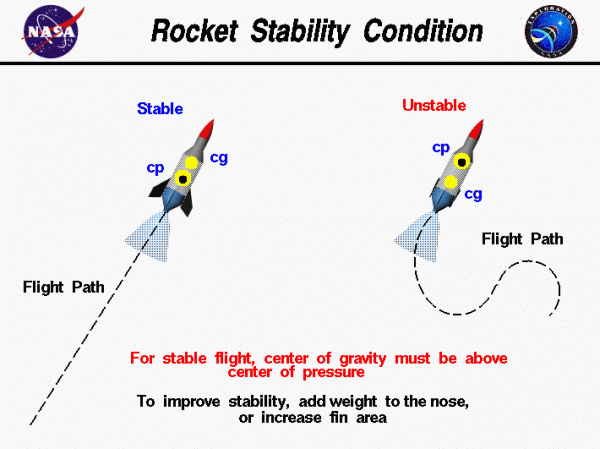Rocket Stability Condition

Rocket Stability
During the flight of a model rocket small gusts of wind or thrust instabilities can cause the rocket to “wobble” or change its attitude in flight. Like any object in flight, a model rocket rotates about its center of gravity cg, shown as a yellow dot on the figure. The rotation causes the axis of the rocket to be inclined at some angle a to the flight path. Whenever the rocket is inclined to the flight path, a lift force is generated by the rocket body and fins, while the aerodynamic drag remains fairly constant for small inclinations. Lift and drag both act through the center of pressure cp of the rocket. This is shown as the black and yellow dot in the figure.
Restoring Force
If the center of gravity is located above the center of pressure, the rocket will return to its initial flight conditions if it is disturbed. Engineers call this a restoring force because the forces “restore” the vehicle to its initial condition and the rocket is said to be stable. Such a flight condition is shown on the left of the figure.
De-Stabilizing Force
If the center of pressure is above the center of gravity, the lift and drag forces maintain their directions but the direction of the torque generated by the forces is reversed. This is called a de-stabilizing force. Any small displacement of the nose generates forces that cause the displacement to increase. Such a flight condition is shown on the right of the figure where the rocket is unstable.
For a stable model rocket, the center of pressure must be located below the center of gravity. To increase the stability of your rocket, add weight to the nose, or increase the area of the fins.
How to Determine the Stability?
There is a relatively simple test that you can use on a model rocket to determine the stability. Tie a string around the body tube at the location of the center of gravity. Be sure to have the parachute and the engine installed. Then swing the rocket in a circle around you while holding the other end of the string. After a few revolutions, if the nose points in the direction of the rotation, the rocket is stable, and the center of pressure is below the center of gravity. If the rocket wobbles, or the tail points in the direction of rotation, the rocket is unstable. You can increase the stability by lowering the center of pressure, increasing the fin area or by raising the center of gravity, for example by adding weight to the nose.
NOTE: Modern full-scale rockets do not usually rely on aerodynamics for stability. Full scale rockets pivot their exhaust nozzles to provide stability and control. That’s why you don’t see fins on a Delta, Titan, or Atlas booster.
